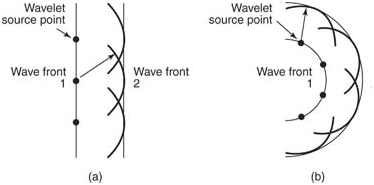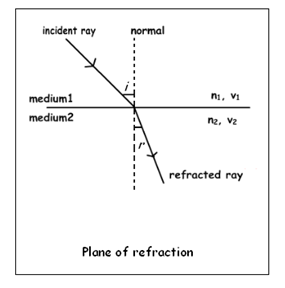Wave Optics

Wave optics is the study of wave nature of a light. It can prove by their two phenomena’s of interference and diffraction.
Wave front is defined as surface joining the points of same phase. The speed with which the wave fronts move away from the source is called phase velocity or wave velocity. The wave transports energy along the lines perpendicular to the wave fronts, with wave velocity. These lines are called as Rays.
Let us know how interference and diffraction are important by different wave models of Light.
Huygens’ principle:
The principle states that the locus of all the particles in the medium which are being disturbed at the same instant of time and are in the same phase of vibration. Huygens considered light to be a wave. He envisioned a wave crest advancing by imagining each point along the wave crest to be source point for small, circular, expanding wavelets, which expand with the speed of the wave. The surface tangent to these wavelets determines the contour of the advancing wave. Figure 1 illustrates Huygens’ construction for a plane wave (a) and for a spherical wave (b).

Huygens ‘Principle can also be used to derive the law of reflection and the law of refraction.
- Determination of Phase Difference:-
The phase difference between two waves at a point will depend upon
(a) The difference in path lengths of the two waves from their respective sources.
(b) The refractive index of the medium
(c) Initial phase difference between the sources if any.
(d) Reflections, if any, in the path followed by waves.
- Reflection of plane wave at plane surface (Laws of reflection):-
(a) The incident ray, the reflected ray and normal to the reflecting surface at the point of incidence, all lie in one plane and that plane is perpendicular to the reflecting surface.

(b) The angle of incidence is equal to the angle of reflection.
So, ∠i = ∠r
This signifies angle of incidence is equal to the angle of reflection
- Refraction of light:- Refraction is the phenomena by virtue of which a wave going from one medium to another undergoes a change in velocity.

(a) The sine of the angle between the incident ray and the normal bears a constant ratio to the sine of the angle between refracted ray and the normal.
sin i/sin r = v1/v2 = 1µ2 = constant
Here, v1 and v2 are the velocities of sound in first and second medium respectively.1µ2 is the refractive index of the second medium with respect to first.
(b) The incident ray, the refracted ray and the normal to the refracting surface lie in the same plane.
- Interference:- The modification in the distribution of light energy obtained by the superposition of two or more waves is called interference.
- Principle of superposition:- It states that a number of waves travelling, simultaneously, in a medium behave independent of each other and the net displacement of the particle, at any instant, is equal to the sum of the individual displacements due to all the waves.
- Displacement equation:– y = Rsin 2π/λ (vt+x/2)
- Amplitude:- R =2a cos πx/λ
- Intensity:-I = K4a2 cos2 (πx/λ) [I = KR2]
- Maxima:-A point having maximum intensity is called maxima.
x = 2n (λ/2)
A point will be a maxima if the two waves reaching there have a path difference of even multiple of λ/2.
Imax = 4Ka2 = 4i (Here, i = Ka2)
· Minima:- A point having minimum intensity is called a minima.x = (2n+1) (λ/2)
A point will be a minima if the two waves reaching there have a path difference of odd multiple of λ/2.
Imin = K. 4a2×0 = 0
· Condition for constructive interference:-Path difference = (2n)λ/2
Phase difference = (2n)π
· Condition for destructive interference:-Path difference = (2n+1)λ/2
Phase difference = (2n+1)π
· Coherent Sources:- Coherent sources are the sources which either have no phase difference or have a constant difference of phase between them.·
Conditions for interference:-(a) The two sources should emit, continuously, waves of same wavelength or frequency.
(b) The amplitudes of the two waves should be either or nearly equal
(c) The two sources should be narrow.
(d) The sources should be close to each other.
(e) The two sources should be coherent one.
Course Features
- Lectures 0
- Quizzes 0
- Skill level All levels
- Language English
- Students 0
- Assessments Yes





